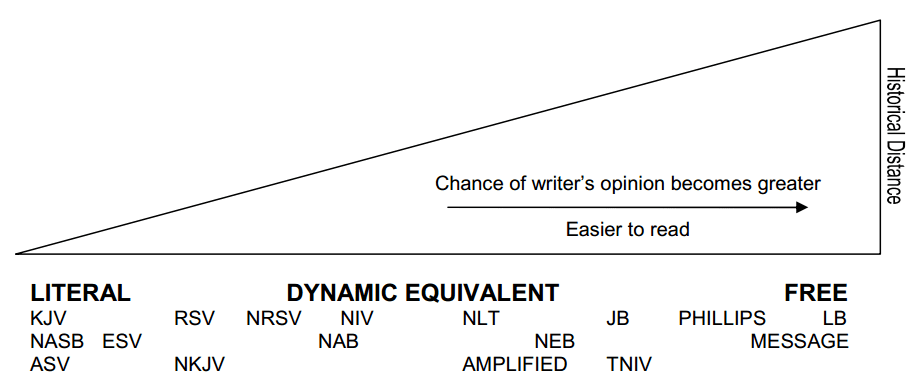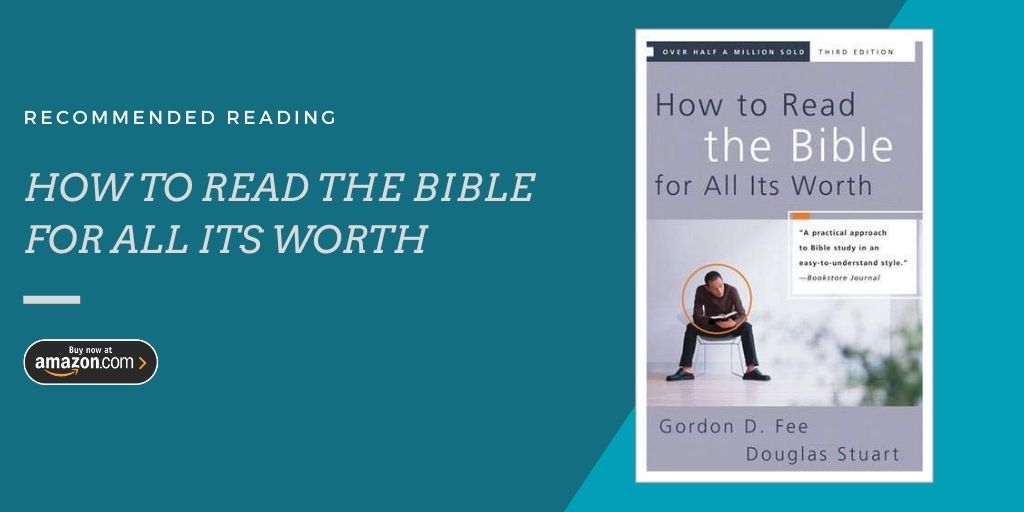Editorial Note: This post is part of how to study the Bible (the complete series).
One question I get more often than any other is, “Which of the Bible translations is the right one?” I’ll share my response to that question a little later. In order to get to the answer to that question, there are a few factors we should take a look at which will help drive us to the answer.
The Languages of the Bible
It always amazes me when people act as though the Bible was written in English, and interpret it as though it was written directly to us with our cultural references. One of the first rules of Bible interpretation is that before it was God’s Word to us, it was first God’s Word to them (the original readers/hearers). And there is a great deal of distance between us and them, starting with the very words that are used, and how they are used to communicate ideas.
Therefore, the first thing we must consider as it relates to Bible translations is the issue of language. During Luther’s time, the Bible and language of the Church were Latin, as it had been for hundreds of years. Ironically, none of the original manuscripts were written in Latin. Rather they were written in Hebrew (Old Testament), Aramaic (primarily Old Testament), and Greek (New Testament).
One of the most important factors to consider when we think about language as it relates to translating is that it’s a very cultural expression. It’s often not enough to think that there is always a clean one-for-one relationship between words. Therefore, if we are to accurately translate and understand the rich messages of the Biblical texts, then we must first grasp the culture from which these languages originate.
It’s also worth noting the origin of the languages in question. Hebrew and Greek (the two primary languages of the Bible) are both primary languages. This means these languages did not have their origin in another language.
In comparison, English is a secondary language, meaning nearly all of our words originate from some other language. Think about one of the most common questions you’re likely to hear at a Scripps Spelling Bee event, “What is the language of origin?” As the English language continues to evolve, new words are formed by adapting words from other cultures.
Culturally-speaking, we also need to consider what life was like. What kind of environment do we live in compared to the environment when the Biblical texts were written? The writers of the Bible all lived in an agricultural society. Today, we live in a technology-driven society. These differences impact how we communicate and use certain words.
The difference can be obvious even in modern, American culture.
Consider the comedy we see in movies and television shows when the world of a rural farmer collides with that of a city slicker. The difference in how the two sides communicate creates a situation where misunderstanding becomes easy. How much more is the potential for misunderstanding when we bring together the writings of a first-century fisherman with a reader who works in an air-conditioned office in a skyscraper in a major city?
Finally, the difference between Eastern and Western cultures can greatly impact our understanding of the Biblical texts. This is probably one of the most significant differences when it comes to interpretation, largely because of the gap between how things are fundamentally perceived between the two sides.
Whereas Western culture focuses more on individuality and self, Eastern culture focuses more on external factors and the surrounding community. This chart highlights some of the key perspectives in these cultures.

One of these cultures represents the society Jesus lived and ministered in, and the other represents the one in which we live and study His life and teachings. Therefore one of the keys to understanding many of the parables Jesus used is also understanding the cultural references in which they were originally told.
It is this gap, often referred to as historical distance, that we must overcome as translators and interpreters of the Biblical texts.
Three Types of English Bible Translations
As we attempt to deal with this historical distance and bring greater cultural relevance to the Scriptures, we see three types of Bible translations emerge. Each has its strengths and weaknesses.
Literal Translation
Also referred to as a word-for-word translation, the goal of this type of translation is to stay as close as possible to the words and phrases used in the original language. Where possible, this translation will attempt to find a single English word to use for each Hebrew or Greek word in the original (earliest available) manuscripts. This kind of translation keeps the historical distance at a minimum, and it keeps the translator’s opinion at a minimum.
However, these kinds of translations can sometimes be more difficult to read. Often a word-for-word translation from one language to another (even among modern languages) is not as smooth and fails to communicate fuller concepts and ideas where there is no exact one-for-one exchange of terminology. When you ask someone who is bilingual with English as a second language what a certain term means, you’ll often find that they have to explain the idea due to the lack of an accurate English word to describe the concept.
Examples of this type include King James Version (KJV), New American Standard Bible (NASB), and the English Standard Version (ESV).
Dynamic Equivalent
Also referred to as a thought-for-thought translation, the goal of this type of translation is to find precise equivalents for words, idioms, and grammatical constructions from the original languages. It attempts to keep historical and factual matters intact while updating language, grammar, and style to improve the communication of ideas into something easier to read and understand by the modern reader.
While improving the communication of ideas and thoughts from the Biblical texts, it also increases the historical distance a bit and allows more room for the opinion of the translator to come through. In order to accommodate for this, we tend to see translation committees with a variety of theological backgrounds and a broad scope of experience come together in order to minimize opinion in the best of these types of translations.
Examples of this type of translation include the New International Version (NIV), the New Living Translation (NLT), and the New Revised Standard Version (NRSV).
Free Translation
Also referred to as a paraphrase, the goal of this type of translation is to communicate ideas from one language to another without trying to maintain the exact structure and word use. This form of translation intentionally increases the historical distance as a way to bring the ideas closer to us as it relates to cultural relevance. They tend to be among the easiest translations to read and understand.
The downside of this type of translation is also an increase in historical distance. This increase means there is greater opportunity for the translator’s opinion to creep in and present factual and historical differences from the original intent. The best translations of this type still take a great amount of care and work hard to account for this linguistic and cultural gap by applying solid exegetical and hermeneutical principles when communicating the ideas of the scriptures.
Examples of this type of translation include the Phillips Version, The Living Bible (LB), and The Message (MSG).

Which Translation is the “Right” Translation?
Considering the strengths and weaknesses of each type of Bible translations, I believe that the right one is… all of them! Each adds its own value to understanding the original, plain meaning of the Biblical texts. That’s why when we link to Scripture passages at BibleDude.life, we usually link to a parallel copy with a literal (usually ESV or NASB), a dynamic equivalent (usually NIV), and a free (usually The Message), so the passage can be read side-by-side. This usually paints a clear picture of the ideas being presented.
The key here is that you fully understand the strengths and limitations of whichever translation you are reading. There are some (like the TNIV) which have come under a great deal of fire in recent years because of how it has taken liberty with things like changing some terms into gender-neutral references (i.e. “son” into “child”). These types of changes can change the meaning, resulting in a more free translation.
It’s not likely that I would ever build a theological belief based on the reading of a passage in The Message. It will, however, improve my understanding of a passage that I’m studying, and/or add value in a more relaxed, devotional reading. When looking for theological understanding, it’s better to lean on a good literal translation, with the help of a good dynamic equivalent for greater depth of concepts.
We see a great deal of debate today about which of the Bible translations is the right one. Some are staunch KJV-only advocates. Others may even opt only for an NIV for reading and study. Each side of the argument fights hard to defend their preferred style of translation.







This is great, Dan!
I often wondered about this. I have a parallel as well as a few other physical Bibles in various versions, plus apps with tons of translations. I love looking up a particular scripture in multiple versions.
That’s awesome! And yeah… looking up passages in multiple translations is a great practice, especially if you understand the approach of the translation.
Thanks for this, Dan! Really helpful and exactly the info I was looking for.
My adult daughter just asked if I had any spare Bibles. :o) I do have a few different translations but, I use them all, so am looking to gift her a new one of her very own. She’s an English major and a wordsmith so I was thinking that the version would definitely matter, but as I write this, I’m starting to think that she’d never be satisfied with a single version – same as me! I’ll gift her a dynamic version, encourage her to read this article, and get a good Bible app for translations.
Thanks again!
Kristine W.
Awesome! I’m glad to hear that this was helpful, and I love your approach to getting her a good foundation in the Word!
This was very helpful. Thank you Dan.
You’re welcome! I’m glad you found it helpful!
Hey Dan. This is great info. Thanks for the perspective. I’ve been looking for an annual Bible that’s NASB. I have an annual NIV (Tyndale Daily Walk Bible), that I’ve read through the last 2 years (highly recommend, BTW). I have an ESV Study Bible that i use a lot for Bible study and cross-reference. I reference NASB a lot in study as well. I’d really love to get a Bible (physical, not digital) that i can notate, carry with, etc, that is an annual Bible and NASB translation. I just cannot find one. Do you know of any? Any thoughts on why it’s so difficult to find?
Hoping you can help. If not, i enjoyed reading your explanation above nonetheless.
Blessings!
Thanks, Ryan! Here’s one I found on Amazon… https://amzn.to/3fYlw4P
Or you can run your own plan and reading schedule here… https://www.christianity.com/bible/year/nasb/c.htm
I love the ESV! That’s my favorite for regular reading. But NASB is my favorite for deep study. But I have physical versions of several translations, and enjoy picking each of them up.
Blessings to you too!
I am Theologian at UEAB and I came across this article and all I can say is “well done good and faithful servant”.
Thanks! I appreciate the feedback!
Once heard that you could read the Bible in three years – highlight and underline as appropriate, make notes. At the end of three years get a new bible and start over – the wisdom being you want to see different things as you read thru. I change versions as well.
That’s a great idea. And I love a good marked-up Bible!